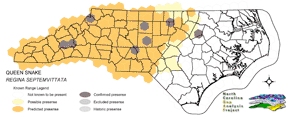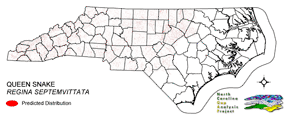
| Taxa: |
| Order: |
| Family: |
| Reptilia |
| Squamata |
| Colubridae |
| NatureServe Global Rank: |
| NatureServe State (NC) Rank: |
| G5 |
| S4 |
| Federal Status: |
| NC State Status: |
| --- |
| --- |


| Land Unit |
| US Fish & Wildlife Service |
| US Forest Service |
| US National Park Service |
| US Department of Defense |
| NC State Parks |
| NC University System |
| NC Wildlife Res. Com. |
| NC Forest Service |
| NC Div. of Coastal Mgmt. |
| Local Governments |
| Non-Governmental Org. |
| Other Public Lands |
| Private Lands |
| GAP Status 1-2 |
| All Protected Lands |
| Statewide |
| Hectares |
| 409.32 |
| 25,775.28 |
| 3,621.69 |
| 8,374.77 |
| 1,036.89 |
| 72.99 |
| 4,151.70 |
| 206.88 |
| 0.00 |
| 1,024.74 |
| 663.75 |
| 76.86 |
| 218,306.07 |
| 15,666.18 |
| 43,822.50 |
| 263,720.94 |
| Acres |
| 1,011.45 |
| 63,692.09 |
| 8,949.39 |
| 20,694.50 |
| 2,562.21 |
| 180.36 |
| 10,259.07 |
| 688.98 |
| 0.00 |
| 2,532.19 |
| 1,640.16 |
| 189.93 |
| 539,445.94 |
| 38,889.73 |
| 108,465.50 |
| 651,846.28 |
| % of Dist. on |
| Prot. Lands |
| 0.9 % |
| 58.8 % |
| 4.9 % |
| 19.1 % |
| 2.4 % |
| 0.2 % |
| 9.4 % |
| 0.5 % |
| 0.0 % |
| 1.4 % |
| 1.4 % |
| 0.1 % |
| 0.0 % |
| 35.7 % |
| ----- |
| ----- |
| % of Dist. on |
| All Lands |
| 0.2 % |
| 9.8 % |
| 1.4 % |
| 3.2 % |
| 0.4 % |
| < 0.1 % |
| 1.6 % |
| < 0.1 % |
| 0.0 % |
| 0.4 % |
| 0.3 % |
| < 0.1 % |
| 82.8 % |
| 5.9 % |
| ----- |
| ----- |
|
NATURE SERVE GLOBAL HABITAT COMMENTS: In and along streams and small rivers with moderate to swift current, stream impoundments; usually in rocky sections of clear streams; bottomland hardwoods and black willow-alder. Often under rocks along shore or in low vegetation at edge of water. Sometimes travels away from water on land. |
| Code | Name | Description | NC Natural Heritage Program Equivalent |
| 380 | Coastal Plain Fresh Water Emergent | Emergent vegetation in fresh water seepage bogs, ponds and riverbeds of the coastal plain. Includes alliances dominated by sedges, eelgrass, as well as cane found in unforested cane-brakes. | Small Depression Pond, Sandhill Seep, Floodplain Pool, Unforested Floodplain Canebrake, Riverscour Prairies, Vernal Pools |
| 173 | Coastal Plain Riverbank Shrubs | Shrub dominated riverbanks, commonly dominated by willows and/or alders. | Sand and Mud Bar |
| 50 | Coastal Plain Mixed Bottomland Forests | Includes forests dominated by a variety of hardwood species, including sweetgum, cottonwood, red maple. | Coastal Plain Bottomland Hardwood (in part), Coastal Plain Levee Forest |
| 49 | Coastal Plain Oak Bottomland Forest | Bottomland forests dominated by deciduous oak alliances. Oaks represented can include swamp chestnut, cherrybark, willow, and/or overcup oak. Inclusions of loblolly pine temporarily flooded forests occur in patches. Hydrology is temporarily to seasonally flooded. | Coastal Plain Bottomland Hardwoods (in part) blackwater subtype, brownwater subtype |
| 385 | Oak Bottomland Forest and Swamp Forest | The swamp chestnut oak, cherrybark oak, shumard oak and sweetgum alliance is one representative. Other alliances are dominated by water, willow, and overcup oaks. Swamp forests can be dominated by sweetgum, red maple, and black gum being dominant. Loblolly can occur in combination with sweetgum and red maple, or with tulip poplar. Includes saturated and semi- to permanently flooded forests in the mountains. | Piedmont/Mountain Bottomland Forest, Piedmont/Mountain Swamp Forest |
| 238 | Piedmont/Mountain Submerged Aquatic Vegetation | Seasonally to permanently flooded areas with aquatic vegetation. Waterlily, pondweed, hydrilla smartweed are a few of the species that can occur. | Piedmont/Mountain Semipermanent Impoundment (in part) |
| 239 | Piedmont/Mountain Emergent Vegetation | Emergent vegetation of all wetland hydrologies. Sites would commonly support species such as tussock sedge, rushs, and cattail alliances. | Rocky Bar and Shore (in part) |
| 267 | Riverbank Shrublands | Riverside shrubs with temporarily flooded hydrologies. Found in the both the Mountains and Piedmont. Containing dominants such as smooth alder and a Carolina or black willows. | Sand and Mud Bar |
| 269 | Floodplain Wet Shrublands | Saturated shrublands of the Piedmont, includes buttonbush, swamp-loosestrife, decodon and alders. | Piedmont/mountain Semipermanent Impoundment |
| 384 | Piedmont/Mountain Mixed Bottomland Hardwood Forests | Includes temporarily to seasonally forests dominated by hardwood species. Hardwoods include sweetgum, red maple, sycamore which co-occur in a mosaic of bottomland and levee positions. Includes alluvial hardwood forests in the mountains. Hemlock and white pine may occur as inclusions, but are generally mapped separately. | Piedmont/Mountain Alluvial Forest, Piedmont/Mountain Levee Forest |
| 202 | Residential Urban | Includes vegetation interspersed in residential areas. Includes lawns, mixed species woodlots, and horticultural shrubs. Vegetation accounts for between 20 - 70% of the cover. | No equivalent |
| 8 | Open water | Open water without aquatic vegetation. | No equivalent |
| 517 | Hemlock Floodplain Forest | Alluvial forest with hemlock and/or white pine in mountains and western piedmont. Hydrology is generally temporarily to seasonally flooded. | Canada Hemlock Forest |
| 522 | Northern Hardwoods | High Elevation forests including yellow birch, American beech, and yellow buckeye. Includes forests with Hemlock and Yellow Birch. | Northern Hardwoods Forest, Boulderfield Forest |
| 526 | Appalachian Cove Forest | Mixed Mesophytic forests of the mountains. Includes tuliptree, basswood, yellow buckeye and surgar maple. This class is mapped to include cove forests dominated or co-dominated by hemlock. | Rich Cove Forest, Acidic Cove Forest |
| 527 | Appalachian Hemlock | Upland hemlock forests of the moutains region. Vary from side slopes to steep slope positions. | Canada Hemlock Forest |
|
Branson, B. A. and E. C. Baker. 1974. An ecological study ofthe queen snake, REGINA SEPTEMVITTATA (Say) in Kentucky. Tulane Stud. Zool. and Bot. 18(4):153-171.
Fitch, H. S. 1970. Reproductive cycles of lizards and snakes. Univ. Kansas Museum Natural History Miscellaneous Publication 52:1-247. Minton, S. A., Jr. 1972. Amphibians and reptiles of Indiana. Indiana Academy Science Monographs 3. v + 346 pp. Mount, R. H. 1975. The Reptiles and Amphibians of Alabama. Auburn University Agricultural Experiment Station, Auburn, Alabama. vii + 347 pp. Behler, J. L., and F. W. King. 1979. The Audubon Society field guide to North American reptiles and amphibians. Alfred A. Knopf, New York. 719 pp. Ashton, R. E., Jr., and P. S. Ashton. 1981. Handbook of Reptiles and Amphibians of Florida. Part One:The Snakes. Windward Pub. Co., Miami, Florida. 176 pp. Vogt, R. G. 1981. Natural history of amphibians and reptiles of Wisconsin. Milwaukee Public Museum. 205 pp. |
For more information please contact them at:
NC-GAP Analysis Project
Dept. of Zoology, NCSU
Campus Box 7617
Raleigh, NC 27695-7617
(919) 513-2853
www.basic.ncsu.edu/ncgap